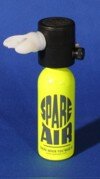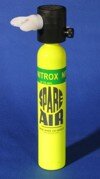So on a dive to 40 ft (typical of shore dives here in S Calif) if you come up at constant rate that's an average depth of 20 ft, so you get 3 mins which is more than enough to make a safe ascent, -- you just won't make your full safety stop. Still a lot better than the guy who has to make an apneic ascent.
Bear in mind that the quoted figures are obtained by experienced divers, using the system in a calm, controlled and stress-free environment (deliberate, planned and prepared use). That means their RMV is also calm, controlled and stress-free.
In a real situation, it is
highly likely that any novice-intermediate diver will be rattling around on the stress-pit, with a massively elevated RMV. Air consumption could be as much as 6-10x greater under those circumstances. That'd mean your breathing time would be measured in
seconds.
Now... imagine how long it would take to get yourself orientated, problem-solve your situation, deploy your Spare Air, clear your head, glance around for your buddy, consider your options, make a decision and
then initiate your ascent....
Exactly
how long does it take a highly stressed to recognise that they are out of air...to confirm their buddy won't support them...to remember they have the Spare Air with them... to deploy and access that air source...to calm and control themselves...to make the decision to ascend. From my experience teaching novice divers, I'd estimate that the process take 30+ second, unless a great deal of repetitive training and rehearsal had been done.
The danger, as you may appreciate, is that having a Spare Air can delude you into thinking you have
time to do that stuff. The Spare Air marketing leads novice divers to believe that. Some forum posts here on SB (
claiming 3 mins breathing time) deludes people into that belief. Ascent calculations based on calm, controlled experimentation delude divers into thinking that. ALL very serious and dangerous delusions to harbour.
Without a Spare Air, the process is virtually instantaneous.. no air, no buddy, no options... kick for the surface.
With a pony cylinder, the diver can
afford to spend that time dealing with their stress,gaining situational awareness and making decisions before ascending.
It's easy to pander to the concept that "any air is better than none". However, that logic falls apart when:
1. Having that 'extra' air causes delays in ascent.
2. Having that 'extra' air causes false-confidence that leads to errors in initial risk assessment.
When I served in the military, I saw the same lesson being taught in many different disciplines. Everyone from fast-jet pilots to infantrymen learnt that reaction speed is directly linked with the number of solutions that have to be considered and rejected
before an ideal solution can be accepted and acted upon. Hence the moniker "Keep It Simple Stupid".
The simplest and fastest solution is to CESA.
Spare Air slows that down - unless ingrained as an instinctive reaction, it presents options, it requires decisions... it adds time. Possibly, adds more time than it gives.
A pony cylinder changes the situation. It adds
lots of time. Slow decision making and problem solving is now available to the diver. Stress management can be used. Situational awareness can be gained.
Any air is better than none? FALSE
TIME is what matters...






